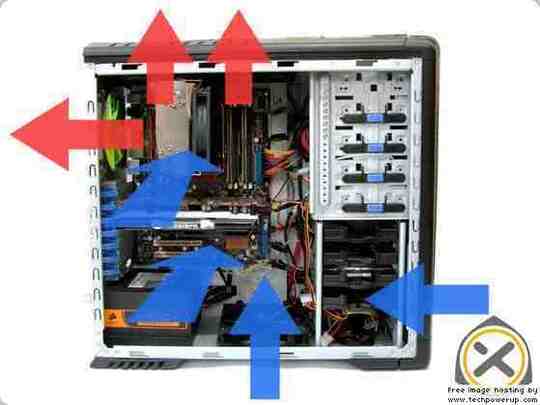1
1
What is the true for fans situation?
Do all fans take away air from case?
Or can there be one with take in function, e.g. in front?
My installation looks like:
Two Top coolers (OUT)
| |
-------------|---|----
|\ v v \
| \ O O \
| |\____________________\
cdrom-> |\ | |
|\\ | CPU Fan-> O <---- System Cooler (OUT)
| \\| |
| \| O O |
|\ | ^---^----------- Two side coolers (IN/OUT)
| \ | |
front ->| O\| |
cooler \ | |
(IN) \ | O <--- Power supply
\|____________________| with embedded cooler (OUT)
Am I right that have put two fans, front fan and one side fan to (IN) mode?
Or must all fans take air away?

all your fans should be input except the top and back. you want the output fans to blow the hot air out, not the room temperature air, so by evacuating heat from the top (as it rises) and the back where the CPU exhaust goes, and feeding air in from the opposite ends is a winning strategy. Nice graphic btw. – Frank Thomas – 2014-07-17T15:48:28.553
I'm just thinking that all fans must be output. Like power supply's fan by default everywhere is output. In this case, all fans move heats out, by default inside the tower heat. This heat must be taken away anyhow. From the physics sight, less air - less corpuscles, less heat. – testaccount – 2014-07-17T15:56:48.210
but you are neglecting the mechanism by which the heat is moved: air. air at room temperature is draw into the box, where it is heated, and then blown out, leaving the system with less heat. if I'm understanding your use of the term Corpuscle, you are thinking on way way too small a scale with your physics. think simple thermodynamics and Bernoulli's principal. inside the box, heat migrates to the matter with the lowest energy state (the room temp air), and is distributed away from the sensitive components. moving air also has some effect from the same mechanism that makes sublimimation work. – Frank Thomas – 2014-07-17T16:23:38.170
@testaccount Fans don't move heat. Fans move air. Heat is transferred away by moving air (this is "convection") as long as the cooler air passes over the hot component and then out of the machine. If all fans are blowing out then you better also have some large open vents to pull sufficient air in and across the hot components, otherwise you're just generally lowering air pressure in the case with minimal heat transfer, and making the fans work hard to keep the air out. If you're not pulling air across the hot components, you're not doing much. – Jason C – 2014-07-17T16:24:04.757
Air however moves like any fluid, so Bernoulli describes how best to move air in, and out of the system. the output fans cannot move more air than is coming in, and the input fans can't push more air in that is blowing out. there is some slight variance from pressure differentials, but its the same principal as putting water through a pipe. the faster the air enters and leaves the system, the more cooling you can achieve by leveraging the temperature difference between the room temp and the component temp. remember you can never cool to below ambient (room) temp, without active refrigeration. – Frank Thomas – 2014-07-17T16:28:12.440
@FrankThomas Well, you know, I suppose you could create a swamp cooler of sorts by passing the intakes over water. It's not really passive (since you have to replace the water somehow, except maybe if you collect rainwater into a large basin below the machine, but now it's going overboard) but it kind of is. You should be able to go below ambient temperature inside the case then. You'd have to be careful of moisture though. – Jason C – 2014-07-17T16:34:33.443
valid point, you can influence the ambient temp the same way you air condition a server room. – Frank Thomas – 2014-07-17T16:38:13.020
possible duplicate of Optimal Fan Placement and Direction for Air-Cooling a Computer
– Jason C – 2014-07-17T18:39:00.573